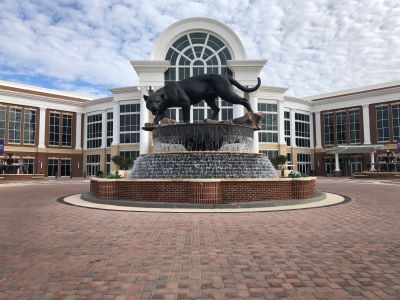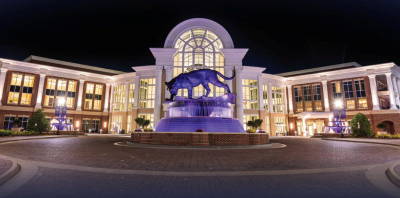The Qubein Arena Panther Fountain project at High Point University in High Point, N.C., was a remarkable endeavor. The exterior circular tiered fountain features a 20-foot bronze sculpture of a panther. The fountain boasts cascading water from upper to lower basins, with carefully selected light-emitting diode (LED) lights illuminating the spectacle.

Located in front of the Qubein Arena and Conference Center, the fountain project was part of a larger $170 million development that includes the arena, the conference center and a hotel. The university sought to create an inspiring and engaging artwork that resonates with fans, students and visitors, while aligning with the university’s values.
The design and creation of the Panther Fountain was led by Brian Keith, an artist specializing in fine art sculptures. Brian Keith Fine Art collaborated closely with the client to ensure that the design met their requirements and preferences. LKC Engineering, represented by Robert Hayter and Lou Sadler, provided engineering expertise and worked on the detailed design aspects of the project, including two additional fountains that flank the larger panther fountain.
The fountain’s construction, architectural finishes, management and mounting of the sculpture, were the responsibility of the general contractor, Smith & Jennings Inc., a full-service grading company founded in 1947. The fountain installation was carried out by Pfists Inc., a company based in Douglasville, Ga., with expertise in fountain installations. Pfists has also worked on numerous other fountains within the High Point University campus.
The fountain is a circular tiered fountain with a diameter of approximately 38 feet and a height of approximately 20 feet. At the top of the fountain, there is a 6-inch-deep upper basin with a 18-foot diameter that houses the platform for the panther sculpture.
Water is introduced to the upper basin beneath the steel platform and flows down to the intermediate pool basin, which has a diameter of 21 feet. “The basin weighs over 6,000 pounds and has 6 inches of water that acts as a weir with water flowing over it like an infinity pool over its entire 360-degree perimeter,” said Robert Hayter of LKC Engineering.
From there, the water cascades down a series of steps to the lower basin before being returned to an equipment vault for filtration and recirculation. As the water flows over the rocks, it agitates the water, making it look like a real waterfall. Hayter added, “This is a very unorthodox design, but it creates a very impactful visual effect.”
The panther design led LKC Engineering to add a rock design into the fountain. This custom design element allowed the panther to be standing on the rocks with water flowing all around.
The panther sculpture itself is unique, representing the athletic icon of the university. “Keith really achieved what the university wanted, all the way down to the way the tail is formed,” Hayter said. The sculpture is made of bronze and weighs more than 5,000 pounds, and it was made in California.
This fountain, in particular, is not meant to be tranquil; it is not subtle or sedate. On the contrary, it is energetic. “Qubein is a first-generation Lebanese who was very successful, and he believes water represents power, energy and life,” Hayter said. “The fountain energizes folks as they come in; it’s a cauldron of energy.”
The fountain equipment includes various components, such as freestanding and flush mount lights, junction boxes, water-level sensors, skimmers, drains, diverter plates, water stops and anti-vortex/diverter sumps. These components were carefully selected and integrated into the fountain design to ensure proper functionality and aesthetics.
The equipment vault houses the necessary pumps, sand filters and UL-listed panels for lighting and fountain controls. It is fully engineered and pre-assembled for easy installation. The fountain’s underground vault and control center is located about 50 feet away and contains all the water treatment, pumps, purification and plumbing. There is nothing in the base of the fountain.
The vault is about the size of an accessible bathroom. “Fountain People are terrific at taking what we draw and design, then make it a reality with pumps, pipes and nozzles,” Hayter said. “They make our visions a reality.”
 The fountain lighting system incorporates both freestanding and niche LED lights, providing illumination in all three basins of the fountain. The specific LED lights used in the project were carefully selected for their functionality and ability to create captivating visual effects.
The fountain lighting system incorporates both freestanding and niche LED lights, providing illumination in all three basins of the fountain. The specific LED lights used in the project were carefully selected for their functionality and ability to create captivating visual effects.
The colors of the lights were chosen specifically to reflect the university’s school color, which is purple, but it can also be programmed to other themes throughout the year—such as red and green at Christmas, and orange during Halloween, etc. “The university puts on an incredible Christmas Open House, and they invite the public, and those LED lights on the fountain are central to the beauty of the event,” Hayter added.
In the upper basin and intermediate pool, a total of 16 freestanding light fixtures were installed. These fixtures are equipped with red, green, blue and white (RGBW) diodes. The RGBW diodes allow for a wide range of options, including individual colors or white light. The LED fixtures can be programmed and controlled using a digital multiplex (DMX) system, enabling dynamic light changing displays during nighttime operations or for special events.
The lower basin features 16 stainless-steel adjustable niche light fixtures integrated into the wall. These provide additional illumination and accentuate the architectural elements of the fountain. Like the freestanding fixtures, the niche LED lights can also be set to individual colors or white, offering flexibility in creating desired lighting effects.
Overall, the combination of the freestanding LED lights with RGBW diodes and stainless-steel niche LEDs enhances the esthetic appeal of the Qubein Arena Panther Fountain, providing an engaging visual experience for spectators, students, families, fans and visitors alike.
Although the panther fountain is the most striking fountain in this space, there are two additional, circular fountains that sit on either side in this large, hardscape area in front of the arena.
While there are several entrances to the building, the fountain with the panther is located at the front as visitors approach the building. It is where people gather, and there are lines of patrons coming to watch athletic events and concerts.
“Designing in this hardscape area, we needed to create a large enough space for many people entering at once, but also to help with the flow of people, for gatherings, and to allow for emergency vehicles and for protection of the building itself,” Hayter explained. “We finally landed on a design with three fountains. The one, larger fountain at the center with the panther, and two smaller circular fountains, which resulted in what we affectionally called ‘Mickey Mouse’s ears.’”
For the two fountains on either side of the panther fountain, Lou Sadler was the primary designer. Sadler was careful to design fountains that were in keeping with the building’s architecture, while complementing the larger fountain. Hayter described the campus as “Georgian architecture, but on steroids” because the scale is not traditional, but the forms and materials are Georgian.
The space greatly impacted the size and scale of the smaller two fountains. “We had to be sure there was room for people as well as EMS, firetrucks, full coach buses around the main fountain and the two smaller fountains had to accommodate UPS and other smaller types of vehicles that pull up to the building, as well as protecting the building and helping with people flow,” Hayter explained.
Sadler began playing with classical European forms of tiered fountains found in French and Italian fountains with scuppers that fall from one to another. The fountains have brick on the lower basin and the precast concrete in the fountains looks like limestone—borrowing from the building’s architecture and incorporating the design into the fountain. Each bowl has its own supply of water that is super-charged, so it looks like the water from the top makes it way to the bottom in a uniform manner, without running out of water by the time it gets to the bottom. These fountains are completely custom-made, using colorized concrete, by a company in Georgia called Georgia Pre-Cast.
These fountains help with the flow of people and keep cars from getting too close to the auditorium for safety. The space is an active drop-off and valet area and is very frequently turned into an urban plaza for use before events in the arena.
The hardscape in this plaza is made up entirely of concrete unit pavers, a style known as Belgium cobble. It is not rough and any shoe can walk on it—from stilettos to sneakers. It is very safe and imitates a stone street or plaza. LKC used paver stones that look like cleft rock. These pavers are in the non-vehicular zones so the texture and type of paver visually indicate they are in a pedestrian zone. The visual cues for pedestrians and vehicles come from the hardscape pavers. In addition, there are crash-rated bollard barricades positioned strategically near the fountains, which are also strong enough to prevent a runaway vehicle from inadvertently making its way toward the building.
The entire approach to the plaza with the fountains is also designed for what is known as “progressive realization.” Visitors cannot see the panther fountain all at once. There are roundabouts and an elliptical lawn that slows the approach to the plaza and challenges the visual perspective from multiple viewpoints as people approach the panther from the street. It is a negotiated centerpiece, meaning one needs to negotiate and head toward the panther, making it a visual reward.
It is important to note that this university has a very robust use of water features throughout the campus. In fact, there is a water feature at every roundabout on campus. There are at least 20 water features, including fountains, sequencing fountains, waterfall fountains, reflecting pools and more. These three fountains are some of the most impressive, but they had to also align with the other fountains on campus.
For More Information:
Qubein Arena & Conference Center: www.highpoint.edu/arena
LKC Engineering: www.lkcengineering.com
Fountain People: www.fountainpeople.com
About the Author
Bryan Had is regional sales manager/engineer for Fountain People, a commercial fountain manufacturing and design firm located in San Marcos, Texas.


